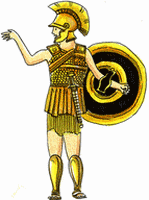Maps of the Antique
Mediterranean Sea
 Greece Greece
 Attic Attic
 Corinth Corinth
 Magna Graecia Magna Graecia
 Apulia Apulia
 Some dates Some dates
 Archaeological sites Archaeological sites
 Pottery and ceramics Pottery and ceramics
 Daunia Daunia
 Gnathia Gnathia
 Campania Campania

|
APULIA: POTTERY AND CERAMICS
From the 8th to the 5th century B.C., in a large movement of colonization, the greek cities spread all around the western Mediterranean sea. Colonies are created in southern Italy and Sicily - the area which will be called later Magna Graecia. These colonies establish with all specificities of a greek city and numerous artists settle down there. The local production starts especially at the end of the 5th century mainly because by this time, Athens - which dominated the trade of ceramics - decline suddently after the Peloponnesian War. Attic painters and potters expatriate to Italy and set up workshops there.
Apparently strongly tied up to its traditions, a part of Apulia will persist in producing potteries which keep geometrical patterns remaining obviously of neolithic inspiration (cf. the Daunians)..
In the area of Apulia which adopts the greek models, the painters apply mainly the red-figure technique Some of their products are so close to their models that they are difficult to distinguish. Other show stylistic differences that allow an immediate identification of their origins :
- the "style of Gnathia" (cf. "Gnathia"), called after the name of the site in Apulia where they were found first, which is quite easy to recognize;
- vases of very large dimensions, especially various types of craters (volute, column, calice an bell craters);
- some often used patterns, like the laurel leaves, representations of birds like ducks or swans. Another extremely frequent theme found on all kinds of vases and plates is the female profile said "lady of fashion" applied in red-figure highlighted with white or yellow paint;
- paintings on black glazed potteries, of red-colored geometrical patterns (chevrons, waves, greek frieze, etc), which defines the "group of Xenon". This term does not report to a place of origin - this production may come from Peucetia - but the word XENON was painted on a kantharos of this style, today exhibited in Frankfurt;
- most of the miniature vases and pots, made of black glazed ceramic and decorated with red painted patterns, in all kinds of shapes (oenochoe, nestoris, skyphos, kantharos, lekanis, olpe…) come also from this area.
Other potteries are more difficult to identify, like the famous owl-skyphos (identical to the Athenian model), some black glazed kantharos without any painting, etc. It is sometimes told that the productions of Magna-Graecia are not as fine as their attic models: the realization of the large craters proves that this statement is not always true.
The origin of terracotta statuettes is also sometimes difficult to identify, athough the style of Canosa often presents characteristical elements and a material generally of lighter color.
|

















